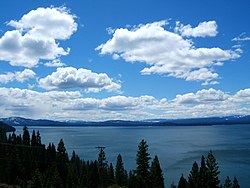Top Qs
Timeline
Chat
Perspective
List of largest reservoirs of California
From Wikipedia, the free encyclopedia
Remove ads
This is a list of the largest reservoirs, or man-made lakes, in the U.S. state of California. All fifty-three reservoirs that contain over 100,000 acre-feet (0.12 km3) of water at maximum capacity are listed. This includes those formed by raising the level of natural lakes, such as at Lake Tahoe. Most large reservoirs in California are owned by the federal Bureau of Reclamation and to a lesser extent the Army Corps of Engineers, many serving the Central Valley Project or State Water Project. Smaller ones are often run by county water agencies or irrigation and flood control districts.

The state has more than one thousand major reservoirs, of which the largest two hundred have a combined capacity of over 41,000,000 acre-feet (51 km3).[1] Most large reservoirs in California are located in the central and northern portions of the state, especially along the large and flood-prone rivers of the Central Valley. Eleven reservoirs have a storage capacity greater than or equal to 1,000,000 acre-feet (1.2 km3); all of these except one are in or on drainages that feed into the Central Valley. The largest single reservoir in California is Shasta Lake, with a full volume of more than 4,552,000 acre-feet (5.615 km3).
Remove ads
List
Remove ads
See also
Notes
- Volume given is the maximum flood pool, not the operational or live storage capacity.
- Not always applicable to off-stream reservoirs.
- In the case of reservoirs with more than one main dam holding it back (e.g. Diamond Valley Lake), the name of the highest one will be given (in this case, the West Dam).
- San Luis Reservoir receives most of its water from the California Aqueduct.
- Diamond Valley Lake is the terminus of the Inland Feeder, part of the California State Water Project, and is also fed by the San Diego Aqueduct.
- This lake is natural, but was raised about 10 feet (3.0 m) by Lake Tahoe Dam, built in 1913.
- Castaic Lake receives most of its water from the West Branch California Aqueduct.
- The reservoir behind Prado Dam is usually empty or close to empty because its primary purpose is flood control. Typical wet season storage is only about 20,000 to 45,000 acre-feet (0.025 to 0.056 km3).
- Clear Lake is a natural lake raised by Cache Creek Dam.
- Lake Casitas is fed by Coyote Creek and water diverted from the Ventura River, which Coyote Creek later flows into.
- Most water supplied from the First San Diego Aqueduct.
- Clear Creek provides a significant portion of the reservoir inflow, but more water enters via the Clear Creek Tunnel, which diverts water from the Trinity River.
- Most of the water supplying the reservoir is diverted from the Middle Fork American River through penstocks for power generation.
References
External links
Wikiwand - on
Seamless Wikipedia browsing. On steroids.
Remove ads















































